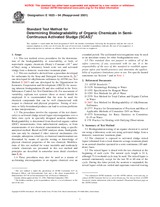We need your consent to use the individual data so that you can see information about your interests, among other things. Click "OK" to give your consent.
ASTM E1625-94(2001)
Standard Test Method for Determining Biodegradability of Organic Chemicals in Semi-Continuous Activated Sludge (SCAS)
STANDARD published on 1.1.2001
The information about the standard:
Designation standards: ASTM E1625-94(2001)
Note: WITHDRAWN
Publication date standards: 1.1.2001
SKU: NS-42427
The number of pages: 7
Approximate weight : 21 g (0.05 lbs)
Country: American technical standard
Category: Technical standards ASTM
Annotation of standard text ASTM E1625-94(2001) :
Keywords:
biodegradability of organic chemicals, Semi-Continuous Activated Sludge, (SCAS), removability, domestic wastewater treatment plant, ICS Number Code 13.060.70 (Examination of water for biological properties)
Additional information
| Significance and Use | ||
|
Secondary wastewater treatment using activated sludge is one of the most important biological treatment processes in use today. The semi-continuous activated sludge (SCAS) test employs activated sludge from a domestic activated sludge plant to assess biodegradation of organic compounds. The SCAS system provides a high potential for biodegradation because of the high biomass to chemical substrate ratio, the regular reinoculation with a variety of microorganisms from the natural sewage, the possibility of co-metabolism because of the variety of organic substrates present in sewage or synthetic feed, the opportunity for slow-growing microorganisms to be retained due to the high sludge age, and a long hydraulic retention time to increase selection pressure. |
||
| 1. Scope | ||
|
1.1 This test method covers procedures for the determination of the biodegradability or removability, or both, of nonvolatile organic chemicals (Henry's Constant <10 -3 atm/m3 /day) using a laboratory bench scale test and activated sludge from a domestic wastewater treatment plant. 1.2 This test method is derived from a procedure developed for surfactants by the Soap and Detergent Association (1, 2), one developed for alkylbenzene sulfonates by ASTM (see Test Method D2667) and one developed by the Organization for Economic Cooperation and Development (OECD) for assessing inherent biodegradation (3) and also codified in the Toxic Substances Control Act Test Guidelines (4). For assessment of variability, replicate test systems (three or more) should be employed. It is recommended that the tests be used for chemical compounds that can be well characterized with respect to chemical and physical properties. Testing of mixtures or fully formulated products can lead to serious problems in data interpretations. 1.3 The procedures involve the exposure of the test chemical(s) to activated sludge mixed liquor microorganisms over a finite time cycle in specially designed aeration chambers. Biodegradability is determined from dissolved organic carbon (DOC) measurements, from radiochemical analyses, or from measurements of test chemical concentration using a specific analytical method. Based on DOC analyses alone, biodegradation can only be claimed if other removal mechanisms (for example, adsorption, volatility, or chemical transformation) are discounted by means of specific testing or knowledge of physical chemical properties of the test chemical. Modifications of this test method for water insoluble and moderately volatile chemicals are presented in this test method and principles are described in somewhat more detail elsewhere (see 5, 6). 1.4 These procedures may also be used as a means of acclimating microorganisms to an organic chemical over an extended period. The acclimated microorganisms may be used as an inoculum source for other biodegradation tests. 1.5 This standard does not purport to address all of the safety concerns, if any, associated with its use. It is the responsibility of the user of this standard to establish appropriate safety and health practices and determine the applicability of regulatory limitations prior to use. For specific hazard statements see Section 8 and in Note 1. |
||
| 2. Referenced Documents | ||
|
We recommend:
Technical standards updating
Do you want to make sure you use only the valid technical standards?
We can offer you a solution which will provide you a monthly overview concerning the updating of standards which you use.
Would you like to know more? Look at this page.




 Cookies
Cookies
